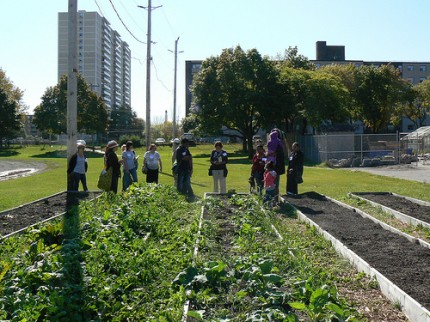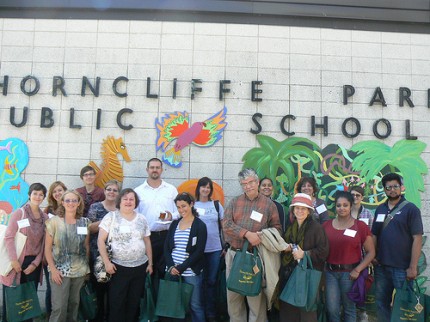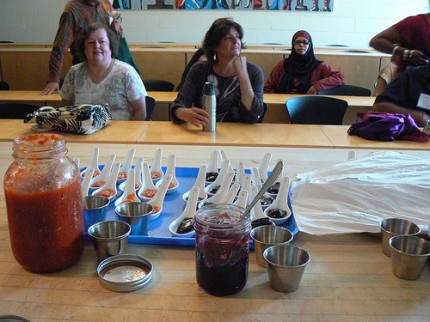City to Country Virtual Tour #11: Food in Schools
Posted: October 30, 2012
Categories: City to Country / Edible Education Network / Food in the News / GoodFoodBites / Growing Good Food Ideas / Virtual Tours
by Sunday Harrison, Green Thumbs Growing Kids
School Food Gardens–Prioritizing Challenges
Food in Schools was one tour in the amazing City to Country mobile conference experience. Jointly led by Foodshare’s Meredith Hayes and Green Thumbs Growing Kids’ Sunday Harrison, participants visited food and gardening programs in four different schools. At Thorncliff Elementary School, participants checked out the largest student nutrition program in the TDSB, which was followed by a tour of Bendale Technical Institute’s urban farm, greenhouse, and amazing commercial kitchen. A visit to Winchester’s Garden Club was next on the agenda – involving a fun-filled lunch recess program complete with a large tribe of snails – while a tour of George Brown’s new local culinary program ended off the day. Throughout the tour, participants completed a prioritizing challenges questionnaire, rating potential challenges to creating and sustaining school food gardens on a scale from 1-5 (1 = high priority, 5 = low priority). The potential challenges have been ranked and are listed in order below. Participants were also asked to suggest solutions to the proposed issues.
1. Relationship with school community Some of the suggested solutions that have proven effective/may be effective include:
- Having free food days
- Having a farmers’ market at the gardens
- Volunteers from the community get to produce
- Increasing awareness of garden-related projects for more involvement
- Making flyers and posting them on community centers and schools about the development of the gardens
2. Funding, Suggested strategies include:
- Getting funding from local companies
- Connecting with organization with similar motives or ideas
- Try having a joint school fundraiser
- Fundraising within schools and communities
3. Summer maintenance, Participants suggested the following:
- Community families voluntarily taking turns sharing the projects
- Hire youth, creating summer jobs for young adults
- Families of the school can help take care of the garden and can use the harvest in return
4. Relationship with school administration, Suggestions included:
- Inviting staff to the events
- Getting the principal’s involvement
- Need to find inside champions
5. Sustainability, Suggestions included:
- Using only re-usable materials
- Planting organic seeds
- No waste of food harvested
- Water barrels to store rain water
- Learning to make the most of the garden space (big or small)
- Composting “keeping the cycle going”
- Teaching the community parents and students about composting through after- school/weekend programs
6. Gardening knowledge, Suggestions included:
- Bring in experts from similar fields
- Sharing ideas and knowledge from community gardeners
- Holding workshops for those interested
- Knowledgeable coordinators teaching volunteers who would pass it down to the community
7. Curriculum links, Suggestions included:
- Creating environmental curriculum in the York region
- Working with teachers and other organizations to come up with programs
- School reserving time for gardening and learning about gardening
- Having farmers come in and talk about gardening
8. Cultural appropriateness, Suggestions included:
- Making the garden a welcoming place for everyone
- Growing crops from different ethnic backgrounds
- Making a list of the different crops available in the garden in the popular community languages
9. Soil Conditions, Suggestions included:
- Taking appropriate amendments
- Soil testing
10. Using the garden harvest, Suggestions included:
- No food wastage
- Giving back to the community e.g. food bank, volunteers, members in need
- Selling at local markets as a fundraiser
- End of the season party open to everyone
- Using food from the garden for cooking programs
- Appreciating the volunteers’ hard work
11. Garden design, Suggestions included:
- Getting input from the community members
- Incorporating design into education/curriculum
- Accessing ideas and designs available online
12. Vandalism , Suggestions included:
- Raising community awareness and involvement to generate respect
- Garden at different times of the day
- Using fences and a lock
One response to “City to Country Virtual Tour #11: Food in Schools”
Leave a Reply
You must be logged in to post a comment.




I am so impressed with this effort. Creating awareness in children is the way to go…